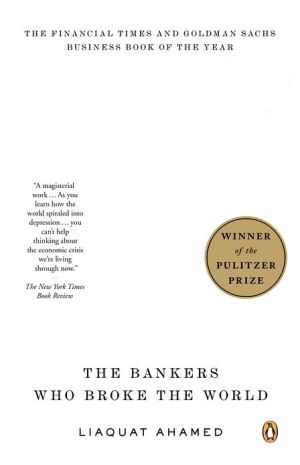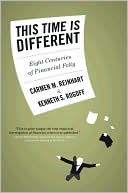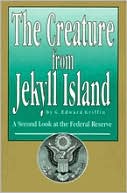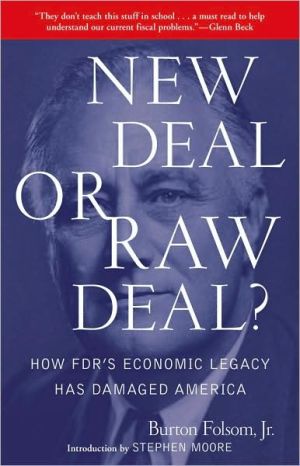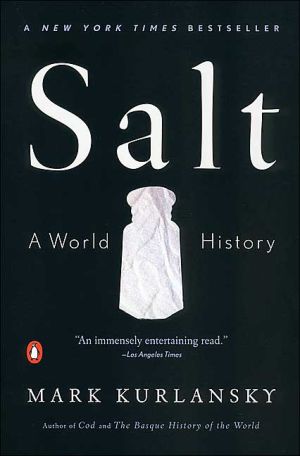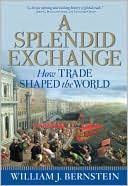Lords of Finance: The Bankers Who Broke the World
Winner of the 2010 Pulitzer Prize\ "A magisterial work...You can't help thinking about the economic crisis we're living through now." —The New York Times Book Review\ It is commonly believed that the Great Depression that began in 1929 resulted from a confluence of events beyond any one person's or government's control. In fact, as Liaquat Ahamed reveals, it was the decisions made by a small number of central bankers that were the primary cause of that economic meltdown, the effects of which...
Search in google:
With penetrating insights for today, this vital history of the world economic collapse of the late 1920s offers unforgettable portraits of the four men whose personal and professional actions as heads of their respective central banks changed the course of the 20th century. The New York Times - Janet Maslin Somehow Mr. Ahamed has been able to peg a many-faceted international economic story to the outsize personalities—one each from the United States, France, Britain and Germany—who made up that rescue team. And he succeeds so well that the potential opacity of his material is easily penetrated. The reader who might not expect to be enthralled by the dangerous mutability of the gold standard, for example, will find it a subject of real fascination. And Mr. Ahamed does a superlative job of explaining the ever-germane way the problems of one shyster, one bank, one treasury or one economy can set off repercussions all around the globe.
Introduction 1Part 1 The Unexpected Storm August 19141 Prologue 192 A Strange and Lonely Man 233 The Young Wizard 354 A Safe Pair of Hands 455 L'Inspecteur Des Finances 616 Money Generals 73Part 2 After The Deluge 1919-237 Demented Inspirations 998 Uncle Shylock 1309 A Barbarous Relic 155Part 3 Sowing A New Wind 1923-2810 A Bridge between Chaos and Hope 17911 The Dawes Opening 19312 The Golden Chancellor 21713 La Bataille 24114 The First Squalls 27015 Un Petit Coup De Whisky 291Part 4 Reaping Another Whirlwind 1928-3316 Into the Vortex 10717 Purging the Rottenness 34718 Magneto Trouble 37419 A Loose Cannon on The Deck of The World 39320 Gold Fetters 422Part 5 Aftermath 1933-4421 Gold Standard on the Booze 45122 The Caravans Move on 47723 Epilogue 497Acknowledgments 506Notes 509Bibliography 533Index 545
\ Janet MaslinSomehow Mr. Ahamed has been able to peg a many-faceted international economic story to the outsize personalities—one each from the United States, France, Britain and Germany—who made up that rescue team. And he succeeds so well that the potential opacity of his material is easily penetrated. The reader who might not expect to be enthralled by the dangerous mutability of the gold standard, for example, will find it a subject of real fascination. And Mr. Ahamed does a superlative job of explaining the ever-germane way the problems of one shyster, one bank, one treasury or one economy can set off repercussions all around the globe.\ —The New York Times\ \ \ \ \ Publishers WeeklyIf you think today's economy is scary, check out the Jazz Age horrors chronicled in this financial history of the interwar years and the central bankers who blighted them. Ahamed, an investment manager, surveys the economic upheavals of the 1920s and 1930s, when crushing war debts and reparations from WWI sparked hyperinflation in Germany and a host of lesser eruptions, all of it climaxing in the American stock market crash and the Great Depression. He tells the story through the central bank chiefs of Britain, France, Germany and the United States as they confront unprecedented crises while "shackled" by the "dead hand" of the gold standard, the era's reigning financial orthodoxy (economist John Maynard Keynes, foe of gold and apostle of economic activism, is the book's hero). The author injects unnecessary commentary about the bankers' neuroses and marital difficulties into his coverage of interest rate and currency fluctuations (New York Federal Reserve head Benjamin Strong, he notes, possessed a "large nose that spoke of ruthlessness"). Fortunately, his protagonists' high-wire efforts to stave off national bankruptcies furnish Ahamed with plenty of drama to highlight his engrossing analysis of the complexities of monetary policy. Photos. (Jan.)\ Copyright © Reed Business Information, a division of Reed Elsevier Inc. All rights reserved.\ \ \ New York Times Book ReviewA grand, sweeping narrative of immense scope and power…From a literary point of view—let me pause to note that this is a beautifully written book; Ahamed has a gift for phrase-making and storytelling that most full-time writer would envy—the decision to build Lords of Finance around these four men is a brilliant conceit.\ —Joe Nocera\ \ \ \ \ Financial TimesLords of Finance is highly readable . . . That it should appear now, as history threatens to repeat itself, compounds its appeal.\ —Niall Ferguson\ \ \ \ \ Library JournalIn this historical study, Ahamed, a professional money manager, sums up the causes of the Great Depression as a series of economic policy blunders that could have been avoided. He cites as causal factors the inflationary financing of World War I by printing money, the insurmountable war debts of Germany and the Allies, Germany's plunge into hyperinflation, and the return of most currencies to the gold standard at excessive and deflationary prewar rates. For example, he explains that when the U.S. stock market bubble burst in 1929 and economic activity collapsed, the central banks were restrained in stimulating the economy for fear of losing their gold reserves. In an epilog, Ahamed draws parallels between the crises of the Great Depression and those in recent times. He keeps his history interesting by highlighting the personalities of the heads of the major central banks, and he employs the economist John Maynard Keynes as a one-man Greek chorus critiquing the bankers' actions. This erudite and exceedingly well-written tale of financial chaos in the 1920s and 1930s is both timely and instructive for today's economic climate. Highly recommended for all academic and most public libraries.\ —Lawrence Maxted\ \ \ \ \ \ Kirkus ReviewsErudite, entertaining macroeconomic history of the lead-up to the Great Depression as seen through the careers of the West's principal bankers. Investment manager Ahamed sets the stage for his story with Toynbeean sweep. The gold standard, to which the major currencies of the world were tied, was thrown into tumult by World War I. France, Britain and Germany found themselves depleted of gold reserves. The United States, a new economic power holding the bulk of the world's gold bullion, demanded repayment of loans made to its allies; this forced large, untenable reparation payments on Germany. The main characters of this unfolding drama were a quartet of bankers who saw themselves as "elite tribunes, standing above the fray of politics, national resentments, and amateur nostrums," and who wielded astonishing, autonomous authority over monetary policy. Eccentric, aristocratic Montagu Norman of the Bank of England dealt with the problem of inadequate gold reserves to support the overvalued pound sterling by convincing Benjamin Strong, head of the Federal Reserve Bank of New York, to lower interest rates in America to encourage the flow of gold back to Europe. This directly fueled the U.S. stock-market bubble, Ahamed argues. The crash of 1929 and the worldwide depression that followed were the inevitable results. Other catalysts included the Reichsbank's irascible, unpredictable Hjalmar Schacht, whose obsession with eliminating reparations led Germany to the brink of default, and vindictive Emile Moreau, whose policy at the Banque de France aimed to destabilize the British pound. Ahamed compares these bankers to the Greek mythological character Sisyphus, condemned to eternal, endless effort."Their goal is a strong economy and stable prices," he writes. "This is, however, the very environment that breeds the sort of overoptimism and speculation that eventually ends up destabilizing the economy." Ahamed soberingly suggests that, "bubbles and crises seem to be deep-rooted in human nature and inherent to the capitalist system."Spellbinding, insightful and, perhaps most important, timely. Author events in New York and Washington, D.C.\ \ \ \ \ From the Publisher"Ahamed...easily connects the dots between the economic crises that rocked the world during the years his book covers and the fiscal emergencies that beset us today." —-The New York Times\ \
